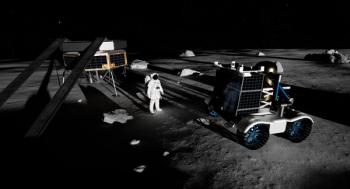
How NASA Scientists are Using Spectroscopy to Study Exoplanets
The study of exoplanets, or planets outside of our solar system, is becoming increasingly important in space exploration. Scientists are working to characterize these planets and Raman spectroscopy is playing a key role. Andrew Mattioda, a research scientist at the National Aeronautics and Space Administration (NASA) Ames Research Center, is on the front lines of this research.
The study of exoplanets, or planets outside of our solar system, is becoming increasingly important in space exploration. Scientists are working to characterize these planets and Raman spectroscopy is playing a key role.
Andrew Mattioda, a research scientist at the National Aeronautics and Space Administration (NASA) Ames Research Center, is on the front lines of this research.
Mattioda leads the Instrument for Carbon Evolution Experiments (ICEE) research group. Since joining NASA’s Ames Astrochemistry and Astrophysics Laboratory, Mattioda has studied the infrared (IR) spectra of polycyclic aromatic hydrocarbons (PAHs), comparing them to IR astronomical observations (1). He has also helped interpret data from NASA missions such as Cassini and the James Webb Space Telescope (JWST), studying how PAHs are processed by radiation sources (1). Currently, Mattioda is serving on the OREOCube and EXOCube platforms being developed by the European Space Agency (ESA) (1). In his role as a senior scientist, his work on these platforms involves studying space radiation and its impact on microorganisms.
Mattioda spoke to Spectroscopyabout how Raman spectroscopy will play a role in the future of space exploration, including the role of the technique in planetary studies.
What role does spectroscopy play in future space exploration?
One of the biggest roles for spectroscopy in the future of space exploration is the study of exoplanets (that is, planets outside our solar system). Recent missions, such as NASA’s Kepler mission, have identified many planets outside our solar system. Now, the quest is on to characterize those planets. The best way to do that is with spectroscopy. That is, by using the planet’s star as a light source, the planet’s atmosphere as the sample, and our telescopes as the detector, we can study the molecules in an exoplanet’s atmosphere.
Inside our own solar system, the use of Raman spectroscopy in planetary exploration has been increasing steadily. This is due to the miniaturization of the instrumentation, its relatively simple design with few, if any, moving parts. The potential identification of organic molecules on Mars by the scanning habitable environments with Raman and luminescence for organics and chemicals (SHERLOC) instrument on the Perseverance rover (2) demonstrates the usefulness of Raman spectroscopy in space exploration. Raman is also a valuable tool in studying materials brought back by sample return missions, such as Stardust, Hayabusa, Hayabusa2, and, in the near future, OSIRIS-REx.
What are some considerations that scientists need to keep in mind when designing spectroscopy instruments that can be used for space exploration applications?
The biggest issues designing spectroscopic instruments for space exploration tend to be size and complexity. Space missions typically have limited amounts of space and mass (weight) available for instruments. Thus, for launching instruments in space, the lighter and smaller the instrument’s footprint, the better. It is also an advantage for the instrument to have as few moving parts as possible since every moving part is a potential source of instrument malfunction. Other items one needs to consider are the amount of data, since it needs to be transmitted back to Earth, and power requirements.
How is your current work advancing space exploration, and what spectroscopic techniques are you using?
Our current work advances space exploration on two different fronts. First, space missions collect spectra that need to be analyzed and interpreted. While the laws of chemistry are the same in space as here on Earth, space environments are out of this world, so to speak. Extreme temperatures, pressures and the presence of ionizing radiation can influence a molecule’s spectrum. Therefore, the first part of my research effort is to collect the spectra (Raman and infrared) of molecules under realistic space and planetary science conditions. The infrared data we collect is stored on a public accessible database, the PAHIR spectral database (3) and is used by astronomers, and other scientists, worldwide to interpret the data from infrared telescopes, such as JWST (James Webb Space Telescope). Having this IR spectral database online and publicly accessible enables scientists to not only interpret their infrared (IR) observations but to use those observations as chemical probes of the universe.
Based on the usefulness of the IR spectral database, we are establishing a Raman spectral database for use by the space science community (4). A publication describing this database will be out shortly. The focus of the Raman spectral database is a bit different in that it is designed more for planetary science missions. For example, we are currently recreating the surface environment of Jupiter’s moon Europa in the laboratory to see how long a potential biomarker, a molecule that can serve as a sign of life, would last on Europa’s surface before its Raman and infrared spectra become indistinguishable from that of other organic molecules. Laboratory work such as this helps us to locate the best areas to look for signs of life as well as interpret a mission’s spectroscopic results.
Is there anything else you think would be important for our readers to know about this topic?
Most people do not think of spectroscopy when someone mentions astronomy. However, astronomical observations allow us to investigate and understand the chemistry of diverse objects, such as exoplanets, dense molecules clouds and even other galaxies, while we cannot travel to them.
References
(1) Nasa.gov, Space Science & Astrobiology @ Ames – Andrew Mattioda.
(2) Sharma, S.; Roppel, R. D.; Murphy, A. E.; et al. Diverse organic-mineral associations in Jezero crater, Mars. Nature 2023, ASAP. DOI:
(3) PAHIR Spectral Database. NASA Ames Research Center.
(4) Ramdb Raman Spectral Database. NASA Ames Research Center.
Newsletter
Get essential updates on the latest spectroscopy technologies, regulatory standards, and best practices—subscribe today to Spectroscopy.



